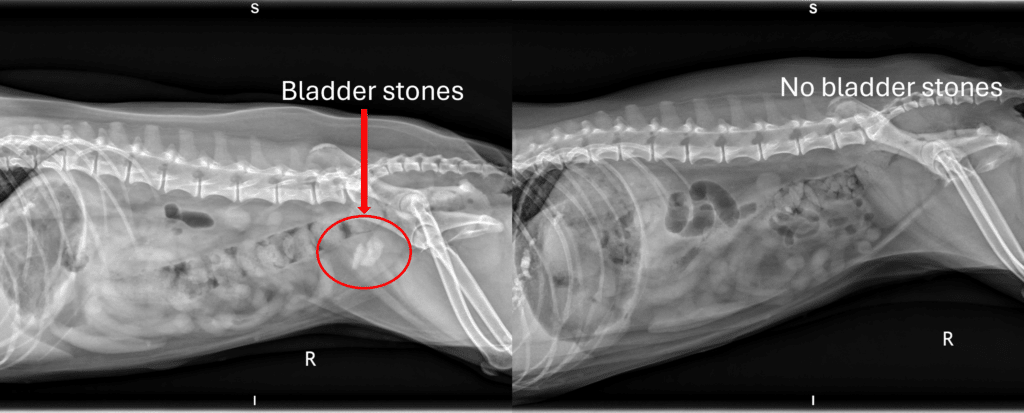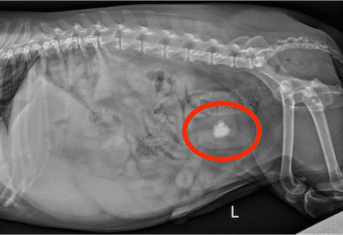Bladder Stones: Now You See Them, Now You Don’t

Bladder Stones: Now You See Them, Now You Don’t
The two x-rays seen below are from the same canine patient, taken one month apart. The one on the left shows two bladder stones. On the right you can see the stones are no longer present in the bladder. How did this magic happen? Surgery? Laser therapy? Antibiotics? Food? Magic wand?

Surgery?
Nope. Surgery may be the fastest and most common treatment for bladder stones, but for this lucky duck dog surgery was not necessary. Bladder surgery is performed under general anesthesia. The surgeon makes an incision in the abdomen near the back legs and finds the bladder just inside the body wall. Because the bladder is a hollow organ, it will collapse when the surgeon makes an incision in the bladder wall. Special sutures are placed in the bladder to hold it up and keep it open while the stones are scooped out of the bladder with a bladder stone spoon.
PCCL?
Huh? This acronym stands for per cutaneous cystolithotomy. Using laparoscopy equipment, a pinhole incision is made in the bladder. A small camera is threaded into the bladder and its magnifying properties are used to visualize the tiniest stones. Using this non-invasive method, stones are busted up using the laser and then easily removed.
Laser therapy?
Guess again. For dogs of the right size with not too many stones, non-invasive bladder stone removal is possible. Stones can be fragmented using a special laser which is passed up the urethra and into the bladder. Once the stones are broken into small enough pieces, they are either flushed out of the bladder or removed with a special stone-removing basket which is passed up the urethra and into the bladder to gather up the stone fragments.
Antibiotics?
Yes, but only in part. I can hear you saying, “Wait a minute, this makes no sense. Stones are hard chunks of mineral. Antibiotics treat bacterial infections, they do not dissolve stone.” But, this dog’s urinalysis showed an infection in addition to the stones. The infection played a role in the development of the stones and without treating the infection, the stones will not disappear.
Diet?
Stones form in the bladder as a sequel to infection and also because there are too many minerals in the urine. Drinking more water dilutes the minerals and helps dissolve the stones. Taking advantage of that information, a diet was formulated to promote water drinking in dogs fed the special stone dissolving diet. The diet is also low in magnesium and phosphorus, the building blocks of a type of bladder stone called struvite. This diet does not work in every type of bladder stone, only the struvite ones. Antibiotics are necessary since as the stone dissolves, it releases bacteria, and thus the dog needs antibiotics until the stones are completely gone. Antibiotics alone will not dissolve the stone and diet won’t work unless the infection is controlled, so the correct answer for the magical disappearance of the bladder stones in this dog is diet AND antibiotics.
Signs of bladder stones
Dogs with bladder stones urinate more frequently than is normal, have accidents in the house and blood in their urine. If you see any signs like this, be sure to have your dog evaluated immediately by your veterinarian. View a prior blog post on bladder stones to see diagnostic images of stones.

































